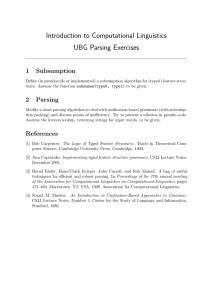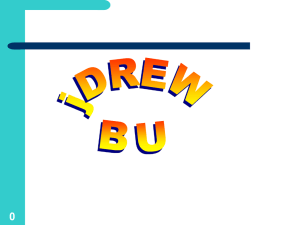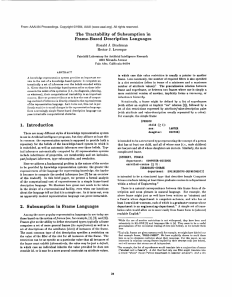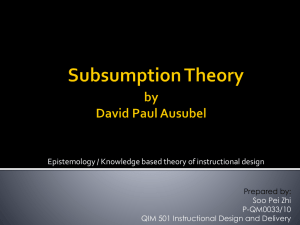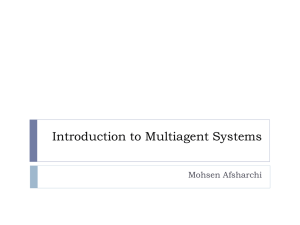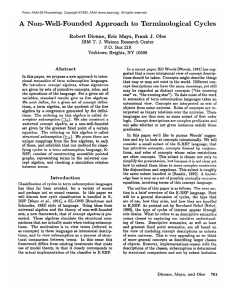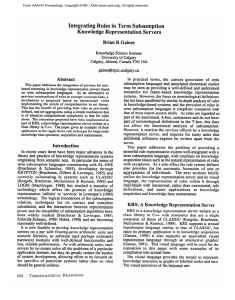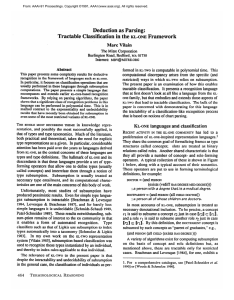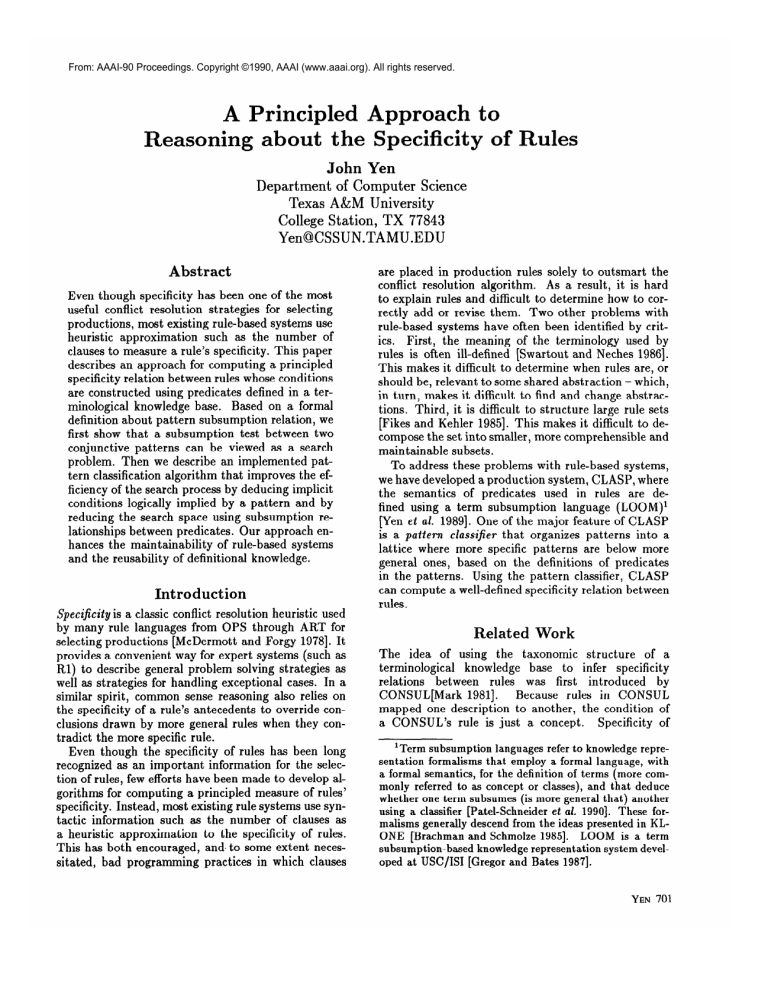
From: AAAI-90 Proceedings. Copyright ©1990, AAAI (www.aaai.org). All rights reserved.
A Principled Approach to
Reasoning about the Specificity of
John Yen
Department of Computer Science
Texas A&M University
College Station, TX 77843
Yen@CSSUN.TAMU.EDU
Abstract
Even though specificity has been one of the most
useful conflict resolution strategies for selecting
productions, most existing rule-based systems use
heuristic approximation such as the number of
clauses to measure a rule’s specificity. This paper
describes an approach for computing a principled
specificity relation between rules whose conditions
are constructed using predicates defined in a terminological knowledge base. Based on a formal
definition about pattern subsumption relation, we
first show that a subsumption test between two
conjunctive patterns can be viewed as a search
problem. Then we describe an implemented pattern classification algorithm that improves the efficiency of the search process by deducing implicit
conditions logically implied by a pattern and by
reducing the search space using subsumption relationships between predicates. Our approach enhances the maintainability of rule-based systems
and the reusability of definitional knowledge.
Introduction
Specificity is a classic conflict resolution heuristic used
by many rule languages from OPS through ART for
selecting productions [McDermott and Forgy 19’781. It
provides a convenient way for expert systems (such as
Rl) to describe general problem solving strategies as
well as strategies for handling exceptional cases. In a
similar spirit, common sense reasoning also relies on
the specificity of a rule’s antecedents to override conclusions drawn by more general rules when they contradict the more specific rule.
Even though the specificity of rules has been long
recognized as an important information for the selection of rules, few efforts have been made to develop algorithms for computing a principled measure of rules’
specificity. Instead, most existing rule systems use syntactic information such as the number of clauses as
a heuristic approximation to the specificity of rules.
This has both encouraged, and. to some extent necessitated, bad programming practices in which clauses
are placed in production rules solely to outsmart the
conflict resolution algorithm. As a result, it is hard
to explain rules and difficult to determine how to correctly add or revise them. Two other problems with
rule-based systems have often been identified by critics. First, the meaning of the terminology used by
rules is often ill-defined [Swartout and Neches 19861.
This makes it difficult to determine when rules are, or
should be, relevant to some shared abstraction - which,
in turn, makes it difficult to find and change abstractions. Third, it is difficult to structure large rule sets
[Fikes and Kehler 19851. This makes it difficult to decompose the set into smaller, more comprehensible and
maintainable subsets.
To address these problems with rule-based systems,
we have developed a production system, CLASP, where
the semantics of predicates used in rules are defined using a term subsumption language (LOOM)’
[Yen et al. 19891. 0 ne of the major feature of CLASP
is a pattern classifier that organizes patterns into a
lattice where more specific patterns are below more
general ones, based on the definitions of predicates
in the patterns. Using the pattern classifier, CLASP
can compute a well-defined specificity relation between
rules.
Related
Work
The idea of using the taxonomic structure of a
terminological knowledge base to infer specificity
relations between rules was first introduced by
CONSUL[Mark 19811. Because rules in CONSUL
mapped one description to another, the condition of
Specificity of
a CONSUL’s rule is just a concept.
‘Term subsu m p tion languages refer to knowledge representation formalisms
that employ a formal language,
with
a formal semantics,
for the definition of terms (more commonly referred to as concept or classes), and that deduce
whether one term subsumes (is more general that) another
using a classifier [Patel-Schneider
et al. 19901. These formalisms generally descend from the ideas presented in KLONE [Brachman
and Schmolze 19851. LOOM is a term
subsumption-based
knowledge representation
system developed at USC/IS1
[Gregor and Bates 19871.
YEN 701
rules can thus be obtained directly from the concept subsumption lattice. To verify the consistency
and completeness of expert systems, researchers have
also developed algorithms for detecting subsumed rules
based on a subset test of clauses [Suwa et al. 1982,
Nguyen et al. 19851. M ore recently, the problem of
computing the subsumption relation between plan
classes has also been explored [Wellman 19881.
Defining
Pattern Subsumption
Relations
Conceptually, a pattern P2 is more specific than (i.e.,
is subsumed by) a pattern Pl if, for all states of the
facts database, a match with P2 implies a match with
Pl. To define the subsumption of patterns more formally, we need to introduce the following terminology.
A pattern is denoted by PX where x denotes the set
of variables in the pattern2. An instantiation of the
pattern is denoted as Px(Z) where Z is a vector of
variable bindings for x . For instance, the expression
PlIq+ ~~2 ?&John
Angela Carl]) denotes an instantiation of Pl that binds pattern variables ?xl, ?x2,
and ?x3 to John, Angela, and Carl respectively. Let
7 be a terminological knowledge base. Concepts and
roles (i.e., relations) are unary predicates and binary
predicates defined in 7. An interpretation 7~ of 7
is a pair (D, E) w here V is a set of individuals described by terms in 7 and 6 is an extension function
that maps concepts in 7 to subsets of V and roles in 7
to subsets of the Cartesian product, V x V, denoted
as V2. PE (Z) denotes that Z satisfies the condition of
the pattern P under the extension function E, i.e.,
is important for using the subsumption of patterns as
a useful measure of the specificity of rules, for the condition of a specific rule often introduces extra variables
to test a situation that is more complicated than the
condition of a general rule. Enforcing that two subsuming patterns have same number of variables will
limit the usefulness of pattern subsumption taxonomy
for controlling the firing of rules. Second, a pattern
Ply subsumes a pattern P2x if and only if Equation
1 holds for all possible interpretations of 7. For
instance, suppose we define a House-owner to be a person who owns at least a house. The pattern (Ownhouse ?x ?y) does not subsume the pattern (Houseowner ?x) because a match with the latter does not
guarantee a match with the former due to incompleteness of the knowledge base (e.g., the system may know
John owns some houses without knowing any specific
houses that are owned by him). Third, the definition
allows the parent pattern to contain extra conditions
that do not have counterparts in the child pattern.
For example, the pattern (robot ?x) V (animal ?x)
subsumes the pattern (super-robot
?robot)
under
the substitution ( ?robot/?x ) even though the condition about (animal ?x> does not have a more specific
counterpart in the child pattern.
To determine whether a pattern Ply subsumes another pattern P2x, we need to find a substitution that
replaces variables in Ply by arguments in P2x such
that the latter terminologically implies the former under the substitution. Terminological
implication,
denoted as 3, is defined as follows: P2x 3
v77
Vx,yEV
0 (C x)~
V’I E V”
iff x E g(C)
* (R x Y)~
[
iff [x, y] E E(R)
e (I1 A 1~)~ iff lf A Zg
where C and R denote concepts and relations defined
in 7; Zr and 12 denote two literals.
Ply and P2x are two patterns
whose predicates are defined in a terminological knowledge base 7. The pattern Ply subsumes P2x, denoted
as Ply? P2x, i$
Definition 1 Suppose
VZT
=
(V,
~)vz’vn
(P2xE(z)*3y’EvmPlyE(Y3)
where Z and y’ are vectors of elements
mension n and m respectively.
(1)
in V, with di-
It is easy to verify that the pattern subsumption relation is reflexive and transitive.
Several important points about our definition of the
pattern subsumption relation are worth mentioning.
First, the definition allows patterns with different number of variables to be compared with each other. This
2When it is not important to refer to the variables of a
pattern, we denote patterns simply by P.
702
KNOWLEDGEREPRESENTATION
(P2X”
Ply
iff
= (VJ)
(5) *
(plx,&
(L??))]
(2)
where the set of variables in x* is a subset of variables
in x , and hence the variable binding of x’ is directly
obtained from that of x . More formally, we have the
following Theorem.
patterns
Ply
and P2x
are
boolean combinations of literals. The pattern Ply subsumes P2x i$ there exists a subsumption substitution
S that replaces variables of Ply
by P2x’s
variables
or constants such that P2x terminologically
implies
Ply/S
based on the terminological
knowledge base 7,
i-e.,
Theorem 1 Suppose
PlytP2x
i$3S
such that P2x
3
Ply/S.
(3)
The proof of the theorem is based on skolemizing the
existentially quantified variable gin Equation 1. Detail
of the proof can be found in pen 19901.
The subsumption substitution S can also be viewed
as a mapping because it maps a variable of of pattern Ply to a variable or a constant in pattern P2x.
We will use the terms “subsumption substitution” and
“subsumption mapping” interchangeably in our discussion. Intuitively, it is easy to see that the existence of
Pl: (:and
(father
?x ?y)
P2: (father
?u ?v)
(father
?x ?z)
)
Figure 1: An Example of Two Indifferent Patterns
a subsumption mapping is a sufficient condition that
P2x is more specific than Ply because, for any instantiation of Pax’s variables, we can construct an instantiation of Ply’s variables from the subsumption
mapping. Thus, matching P2x implies matching Ply
if a subsumption mapping exists.
We further define the following relationships between patterns:
o Two patterns are indifferent, denoted bY -> if and
only if they subsume each other, i.e.,
Pl -
P2
u
P&P2
A P2hPl.
Indifferent patterns are merged in the specificity lattice. Conceptually, two patterns are indifferent if, for
any states of the fact database, either both patterns
match or neither of them matches the fact database.
e Two patterns are equivalent, denoted by E, if they
are indifferent and the subsumption mapping is a
one-to-one mapping between variables of the two
patterns. Two indifferent patterns may not be equivalent. For instance, the patterns Pl and P2 in Figure 1 are indifferent because Pl subsumes P2 under
the substitution ( ?u/?x, ?v/?y, ?v/?z ) and P2 subsumes Pl under the substitution ( ?x/?u, ?y/?v )
or ( ?x/?u, ?z/?v ). But the two patterns are not
equivalent because they have different instantiations
for a given facts database.
o Two patterns are equal, denoted by =, if they are
equivalent under a subsumption mapping that maps
each variable to a variable with the same name.
The subsumption substitution differs from substitution in unification in that it is directional. It substitutes variables/constants of a child pattern for variables of a parent pattern, but not the other way. This
distinction is due to the fact that a subsumption test is
meant to test implications, which is directional, while
unification is meant to test equality, which is bidirectional.
Classifying
Conjunctive
Patterns
This section describes an algorithm for classifying patterns that are conjunctions of non-negated literals
The
(which we will refer to as conjunctive patterns).
algorithm consists of two steps. First, each pattern is
normalized by making explicit in the pattern any unstated conditions logically implied by the patterns and
the terminological knowledge. Second, the algorithm
searches for a subsumption substitutions between pairs
of normalized patterns.
A General Strategy
The general strategy of CLASP’s pattern classification
algorithm is to simplify the subsumption test between
pairs of patterns by first normalizing them. This strategy is analogous to completing a concept definition
before actually classifying the concept in KL-ONE’s
classifier[Schmolze and Lipkis 19831. To formally justify our approach, this section first defines normalized
patterns, then describes a theorem about the subsumption test of normalized conjunctive patterns.
A pattern is normalized if it contains no implicit
conditions other than those that can be deduced easily from the subsumption lattice of concepts and of
roles, which has been precomputed by LOOM’s classifier. More formally, we define a normalized pattern as
follows:
Definition 2 A pattern P is said to be normalized i$
Vl, if P 3 1, then 31’ in P such that 1’3 1
where 1 and l’s are literals with the same
arguments.
number
(4)
of
We say a pattern F is a normalized form of p if and
only if ‘Ti is normalized and P equals F (i.e., they are
equivalent without variable substitution).
The rationale behind normalizing patterns is to simplify the subsumption test. Without the normalization process, the search for a subsumption substitution would have to consider the possibility that a
condition in the parent pattern subsumes a conjunctive subpattern of the child pattern. For example,
consider rules R2 and R3 in Figure 4. The condition (College-graduate
?y)in R2 subsumes thesub?z) A (Child ?z ?w)
pattern (Successful-Father
of R3’s condition under the substitution ?~/?a. Having deduced the conditions implied by these conjunctive subpatterns during the normalization process, the
subsumption test only needs to consider pairs of conditions with the same arity (one from the parent pattern,
one from the child pattern) for testing subsumption
possibility of the two patterns. Thus, normalizing patterns significantly reduces the complexity of the subsumption test. The following theorem formally states
the impact of pattern normalization to the subsumption test.
Theorem 2 Suppose
conjunctive
Pl
and P2
are two normalized
patterns:
Pl = 1; A 1; A . ..r.
(5)
P2 = 1; A 1; A . ..I&
(6)
where 1: and 1; are literals without negations.
The pattern PI subsumes P2 if and only if there exists a subsumption substitution S such that every literall! in PI
subsumes at least one literal in P2 with the same arity,
i.e.,
PIkP2
3s [Vlt in Pl,
3;
in P2,
e
such that 1; 3
1:/s]
(7)
YEN 703
where li and lj have the same number
of arguments.
(defrule
PIhP2
(P2 5 l,lls)
e, 3s
A (P2 3
A . ..(P2
3
l;/S)
Normalizing
Pat terns
The normalization step transforms each pattern into
an equivalent normalized pattern. Five kinds of normalization steps have been implemented in CLASP: (1)
domain and range deductions, (2) normalizing unary
conditions, (3) normalizing binary conditions, (4) value
restriction deductions, and (5) at-least-one deductions.
Each normalization step will be described and illustrated with examples, based on Figures 3 and 4. These
normalization steps are correct because each one transforms a pattern into an equivalent one based on the semantics of LOOM’s term-forming expressions in Figure
2.
1. Domain and Range Deduction:
This step deduces
unary conditions about variables that appear in
a binary condition using domains and ranges of
the condition’s predicate (i.e., a relation). For instance, this step will infer an implicit condition of
R3 (Vehicle ?c> from the range of Has-car relation.
Unary Conditions:
Unary conditions
that involve the same variables are replaced by one
2. Normalizing
unary condition whose predicate is the conjunction
of the unary predicates (i.e., concepts) in the original
pattern. This ensures that all patterns are transformed into a canonical form where each variable
has at most one unary condition. The conditionside of R2 thus is normalized to combine two unary
KNOWLEDGE
REPR~~~~~TATIoN
(defrule
R3
:when (:and
(8)
Proof of Lemma 1 and Theorem 2 can be found in
pen 19901.
Comparing Equations 3 and 7, we can see immediately that the complexity of the subsumption test
has been reduced significantly by first normalizing the
patterns. Based on Theorem 2, computing whether
P2 is more specific than Pl only requires searching for
a subsumption mapping such that each condition (i.e.,
literal) in Pl subsumes at least one condition (i.e., literal) in P2 under the mapping. We will refer to a P2’s
condition that is subsumed by a condition 1; in Pl
as Ii’s subsumee.
The subsumption test between normalized conjunctive patterns, thus, is a simpler search
problem. The following two sections describe the normalization of patterns and the subsumption test between normalized patterns implemented in CLASP.
704
.. . 1
such that
l;ls)
?y>
(Child ?x ?y)
(Car-Owner ?y))
Lemma 1 Suppose PI is a conjunction of n literals,
i.e., Pl = 1: A 1: A ***I1nr where I11, l12, . ..lA are literals
without negations.
The pattern PI subsumes a pattern
P2 if and only if there exists a subsumption
substitution such that each literals 1’ subsumes the pattern P2
under the substitution,
i.e.,
R2
: when ( : and (College-graduate
To prove the theorem, we first introduce the following
lemma.
(Successful-Father
(Father ?f)
(Child ?z ?w)
(Son ?f Fred)
(Female ?w)
(Has-Car ?w ?c))
?z)
... 1
Figure 4: Two Rules Before Normalization
conditions about the variable ?x.
dition (College-graduate&Car-Owner
College-graduate&Car-Owner
College-graduate
into one con?y> where
is the conjunct of
and Car-Owner.
Normalizing
Binary Conditions:
Binary conditions
with the same arguments are collected, and replaced
by a new composite binary condition that takes into
account the unary conditions of its domain variable
and its range variable. This ensures that all normal-
ized patterns have at most two binary conditions
for each variable pair (the argument position of the
variables can be switched). For instance, the conditions in R3 (Child ?z ?w) A (Female ?w) are
transformed to (Daughter ?z ?w> A (Female ?w).
Value Restriction
Deduction:
Suppose a pattern
contains conditions of the form
( :and (Cl ?x> (R ?x ?y) . . . -1 and the definition of Cl in the terminological space has
a value restriction on R, say C2.
Then the
pattern is equivalent to a pattern that has an
additional unary condition (C2 ?y).
For example, conditions (Successful-Father
?z> and
(Daughter ?z ?w) in R3 deduce an implicit condition (College-graduate
?w) because successfulfather has been defined as a father all whose children, which include daughters, are college graduates
as shown in Figure 3 .
5. At-least-one Deduction:
A pattern containing two
conditions in the form of
(:and
...
(C ?x)
...
(R ?x a)
. ..).
where LYis either a variable or a constant, is transformed to one that replaces C by the concept C’
defined below, which has an additional at-least-one
number restriction on the relation R.
(def concept CJ (:and C (:at-least
1 R)))
Following our example, the conditions (Female ?w>
and (Has-car ?w ?c) in R3 now can deduce another implicit condition about ?w: (Car-owner ?w>,
for Car-Owner has been defined to be a person who
Expression
e
Interpretation
(:and Cl CZ)
(:and RI &)
(:at-least 1 R)
(:a11 R C)
(:domain C)
(:range C)
r4
X=[C1](2gA
[C2](4
h/. [&1(x,Y)A[R21@9
Y)
Xx.3. BRI(x>
Y)
xx.b. I[Rl(x,
Y)+ [qb)
h/- [Cl(x)
h/- [Cl(Y)
Figure 2: Semantics of Some Term-Forming Expressions
(defconcept
(defconcept
(defconcept
(defconcept
(defrelation
(defrelation
(defrelation
(defconcept
(defconcept
Person (:primitive))
Hale (:and Person
:primitive))
Female (:and Person :primitive))
College-graduate
(:and Person :primitive))
Child (:and :primitive
(:domain Person) (:range Person)))
Daughter (:and Child (:range Female)))
Son ( : and Child ( : range Male)) )
Father (: and Male (:at-least
1 Child )))
Successful-Father
(:and Father (:a11 Child College-graduate)))
(defrelation
Has-car
(defconcept
Car-owner
(:and
:primitive
(:and
Person
(:domain
(:at-least
Person)
(:range
Vehicle)))
1 Has-car)))
Figure 3: An Example of Terminological Knowledge
(defrule
R2
: when
(:and (Person
Reducing the Search Space Although an exhaustive search that considers all possible mappings can
not be avoided in the worst case, the search space of
?x)
(College-graduate&Car-Owner
(Child ?x ?y))
... >
?y)
(defrule
R3
: when
(:and (Successful-Father
?z)
(Female&Co11 ege-graduate&Car-owner
(Daughter ?z ?w)
(Father
?f)
(Vehicle
?c)
(Son ?f Fred)
(Has-Car ?w ?c))
... 1
Figure 5: Two rules after normalization
has at least one car.
Figure 5 shows the condition-sides of R2 and R3 after they have been normalized. It is easier to see that
R3 is actually more specific than R2, which was not
obvious prior to normalization.
Testing Subsumption
of Normalized
Conjunctive
Pat terns
possible subsumption mapping can be significantly reduced in most cases by considering the subsumption
relationship between predicates. Normally, the condition pattern of a rule consists of several different predicates, only a small percentage of which are subsumed
by a predicate in another pattern. Thus, using the
subsumption relationships between predicates, we can
?w) significantly reduce the the search space for finding a
subsumption mapping.
Our strategy is to identify potential subsumees for
all literals in the parent pattern Pl. A literal 12 is a
potential subsumee of a literal 11 if there exists a subsumption substitution S such that 12 $11/S.
The set
of potential subsumees of a unary literal determines
a set of potential candidates (which we call potential
images) that a variable can map to under a subsumption mapping. The set of potential subsumees of a
binary literal generates mapping constraints on how
pairs of variables should be mapped. Potential images
are used to reduce the branching factor of the search
space, and mapping constraints are used to prune the
search tree. This is illustrated using the example in
Figure 5. Only two conditions in R3, (Son ?x Fred)
and (Daughter ?z ?w), can potentially be subsumed
by (Cdhild ?x ?y) in R2. Since (Child ?x ?y) must
have a subsumee under a subsumption mapping, we
can infer that any subsumption mapping that proves
YEN 705
R3 is more specific than R2 has to satisfy one of the following two mapping constraints: (1) If (Child ?x ?y)
subsumes (Son ?f Fred), then the variable ?x should
map to ?f and the variable?y should map to Fred. (2)
If (Child ?x ?y) subsumes (Daughter ?z ?w), then
the variable ?x should map to ?z and the variable ?y
should map to ?w. Similarly, potential subsumees of
a parent pattern’s unary condition restrict the candidate images a variable can map to. Using the example in Figure 5 again, (Successful-father
?z) and
(Father ?f) are the only two unary conditions in R3
that can potentially be subsumed by (Person ?x> in
R2. Hence, the potential images of ?x are ?z and ?f.
The process of reducing the search space can also
detect early failure of the subsumption test. The subsumption test terminates and returns false whenever
(1) it fails to find any potential images for a variable
in P2; or (2) a b inary condition in Pl fails to find any
binary condition in P2 as a potential subsumee.
Determining the subsumption of normalized conjunctive patterns is NP-complete, for it can be reduced from the problem of determining subgraph isomorphism for directed graphs, which is known to be
NP-complete.
However, worst case rarely occur in
practice. To analyze the behavior of an algorithm in
reality, we have defined normal cases 3 and have shown
that the complexity of the algorithm for normal cases
is polynomial pen 19901.
Brachman and Levesque have demonstrated that
there is an important tradeoff between the expressiveness of a terminological language and the complexity
of its reasoner [Brachman and Levesque 19841. A similarly tradeoff between the computational complexity
of the normalization process and the expressiveness of
the terminological language has also been investigated
[Yen 19901.
Searching for a Subsumption Substitution
A
subsumption mapping between two normalized patterns is constrained by the potential images of each
variables in the parent pattern and the mapping constraints imposed by binary conditions of the parent
pattern Pl. To search for a subsumption mapping that
satisfies these constraints, which are generated by algorithms discussed in previous sections, the pattern classifier first sorts the parent variables in increasing order
of the number of their potential images, then performs
a dependency-directed backtracking. The position of a
variable in the sorted list corresponds to the level it’s
images are assigned in the search tree. At each node,
the current assignment of variables’ images are checked
to see if it satisfies the mapping constraints. If it does
not satisfy any of the mapping constraint, the algorithm backtrack to the closest node whose assignment
causes a constraint violation.
We have presented a principled approach to computing
the specificity of rules whose conditions are constructed
from terms defined using a terminological language.
Based on a formal definition of pattern subsumption
relation, we first show that the subsumption test between conjunctive patterns can be viewed as a search
problem. Then we describe a pattern classification algorithm that improves the efficiency of the search process in two ways. First, implicit conditions logically
implied by a pattern is made explicit before the search
step. Second, the algorithm attempts to reduce the
search space using information about the subsumption
relation between predicates.
Our approach offers several important benefits to the
developers of rule-based systems. First, the pattern
classifier makes it possible to provide, for the first time,
a principled account of the notion of rule-specificity as
a guide to conflict resolution. This will greatly improves the predictability of rule-based systems, and
thus alleviate the problems in maintaining them. Second, using pattern classifier to compute the specificity
of methods, CLASP is able to generalize methods in
object-oriented programming for describing a complex
situation to which the method applies. Third, separating definitional knowledge from rules enhances the
reusability of knowledge and the explanation capability of the system. Finally, the pattern classifier is also
the enabling technology for our future development of
a rule base organizer, which automatically determines
groupings of a large set of rules based on the semantics
of rules and rule classes.
Discussion
We have shown elsewhere that CLASP’s pattern classification algorithm is sound [Yen 19901. It is also
complete for a simple term subsumption language
whose expressiveness is equivalent to that of FCC- in
[Brachman and Levesque 19841. In general, an implementation of our pattern classification algorithm is
sound if (1) th e normalization step transforms an input pattern to an equivalent one, and (2) all identified potential subsumees are correct (which requires
the classifier to be sound). An implementation of the
general algorithm is complete if (1) the normalization
step transforms an input pattern into its normalized
equivalent form, and (2) the complete set of potential
subsumees are identified for each literals of the parent pattern (which requires the classifier to be complete). A more detailed discussion on the issues regarding soundness and completeness of the pattern classification algorithm can be found in [Yen 19901.
706
KNOWLEDGEREPRESENTATION
Summary
Acknowledgements
I would like to thank Robert Neches for his encouragement and support of this research. I am also grate3Using normal cases to analyze the complexity
tractable
algorithm
has been suggested
by Bernard
[Nebel 19891.
of inNebel
ful to Robert MacGregor, Bill Swartout, and David
Benjamin for their fruitful ideas regarding the the pattern classification algorithm. Finally, the research on
CLASP has benefited from many discussions with Paul
Rosenbloom and John Granacki. Part of the work described in this paper was supported by Engineering
Excellence Fund at Texas A&M University.
References
[Brachman and Levesque, 19841 Ronald J. Brachman
The tractability of
and Hector J. Levesque.
subsumption in frame-based description languages.
pages 34-37, Austin,
In Proceedings of AAAI-84,
Texas, August 1984.
kl-one knowledge representation system. In Proceedings of the Eighth International
Joint Conference
Artifkial Intelligence. IJCAI, 1983.
on
[Suwa et al., 19821 Motoi Suwa, A. Carlisle Scott, and
Edward H. Shortliffe. An approach to verifying completeness and consistency in a rule-based expert system. AI Magazine, 3(4):16-21, Fall 1982.
[Swartout and Neches, 19861 William Swartout and
Robert Neches. The shifting terminological space:
An impediment to evolvability. In AAAI-86,
Proceedings of the National Conference
on Artificial Intelligence, Philadelphia, PA, August 1986. AAAI.
[Brachman and Schmolze, 19851 R.J. Brachman and
J .G. Schmolze. An overview of the kl-one knowledge
representation system.
Cognitive Science,
pages
171-216, August 1985.
[Wellman, 19881 Michael P. Wellman. Formulation
of
Tradeofls in Planning Under Uncertainty. PhD thesis, Massachusetts Institute of Technology, Department of Electrical Engineering and Computer Science, 1988. Also distributed as a Computer Science
Laboratory technical report MIT/LCS/TR-427.
[Fikes and Kehler, 19851 R. Fikes and T. Kehler. The
role of frame-based representation in reasoning.
Communication
ofthe ACM, 28(g), September 1985.
pen et al., 19891 John Yen, Robert Neches, and
Robert MacGregor. Using terrninological models to
enhance the rule-based paradigm. In Proceedings
[Gregor and Bates, 19871 Robert Mac Gregor and
Raymond Bates. The loom knowledge representation language. Technical Report ISI/RS-87-188,
USC/Information Sciences Institute, 1987.
[Mark, 19811 W i11iam Mark. Representation and inference in the consul system. In Proceedings of the
Seventh International
Joint Conference
on Artificial
Intelligence,
pages 375-381. IJCAI, Morgan Kauf-
of the Second International
Symposium
on Artificial Intelligence, Monterrey, Mexico, October 25-27
1989.
ven, 19901 John Y en. Reasoning about specificity of
patterns in term subsumption-based systems. Technical Report TAMU 90-003, Department of Computer Science, Texas A&M University, February
1990.
man, 1981.
[McDermott and Forgy, 19781
J. McDermott and C. Forgy. Production system conflict resolution strategies. In D. A. Waterman and
F. Hayes-Roth, editors, Pattern-Directed
Inference
Systems. Academic Press, New York, 1978.
[Nebel, 19891 Bernhard Nebel. Terminological reasoning is inherently intractable. Technical Report IWBS
Report 82, IWBS, IBM Deutschland, W. Germany,
October 1989.
[Nguyen et al., 19851 T. A. Nguyen, W. A. Perkins,
and T. J. Laffey. Checking an expert system knowledge base for consistency and completeness. In Proceedings of IJCAI-85,
pages 375-378, Los Angeles,
CA, August 1985.
[Patel-Schneider et al., 19901
Peter F. Patel-Schneider, Bernd Owsnicki-Klewe,
Alfred Kobsa, Nicola Guarino, Robert MacGregor,
William S. Mark, Deborah McGuinness, Bernhard
Nebel, Albrecht Schmiedel, and John Yen. Report
on the workshop on term subsumption languages in
knowledge representation. to appear in AI Magazine, 1990.
[Schmolze and Lipkis, 19831 James
Schmolze and Thomas Lipkis. Classification in the
YEN 707

